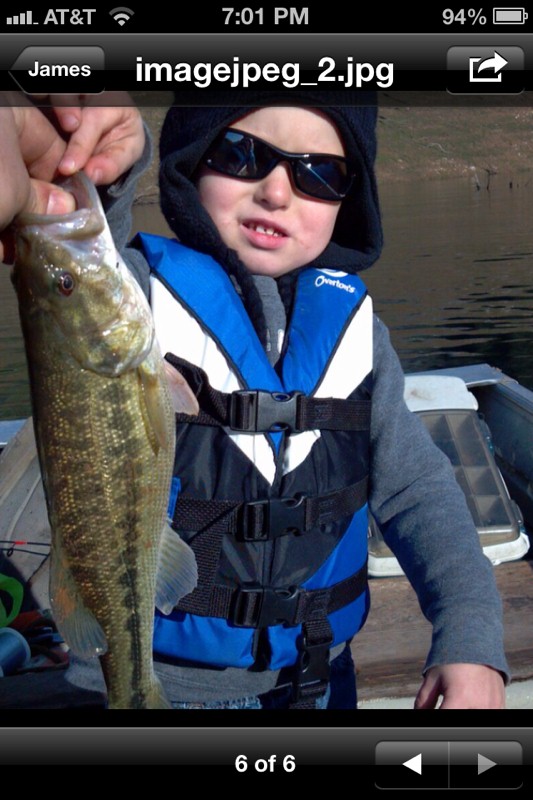2-18-13
Water Conditions: New Melones Lake is currently holding 1,617,090 acre-feet
of water. The lake level dropped two feet this week, and is currently
at 1015 ft. above sea level and 72 ft. from full. Water temperature
warmed a little and is 50-54 degrees. The lake is clear, to slightly
stained with some debris floating on the surface. The lake has turned
over.
Trout: Slow.
Department of Fish and Game is now planting rainbow trout weekly at New
Melones. The lake has turned over. The trout are still scatter
throughout the lake from 0-30' deep. Trolling anglers
caught a few fish trolling the main lake and upriver. The fish are hard
to find. The anglers that are catching them are spending the entire day
on the water to get them. A crawler trolled behind a flasher our sling
blade continues to be the most productive setup. Generally in past years
this is a great time to target brown trout. Try using large plugs or
rolling shad to catch these big fish. It looks like we will be getting a
little rain, and some cloud cover. Use gold, copper, and fire tiger
baits during low light conditions. These colors will stand out and you
will get more strikes. Bank fishing was a little slow
this week with only a few fish being caught per angler. The standard
bait rig with a long leader seems to be your best bet. Use a sliding
sinker with a 3-4' leader and a light wire hook. A crawler/mallow combo
is a proven fish catcher. Another good setup is a Berkley Pinched
Crawler with a pink or white Gulp, or Power Egg. Also, try using a shad
patterned casting spoon on main lake points. Kastmasters and Krocodiles
are great baits because you can cast them a long distance. Fan cast
from deep to shallow to locate were the fish are feeding. Check areas of
the lake near fresh running water. Running water flushes nutrients and
insect into the water for fish to feed on. Don't forget to add scent to
your bait. Garlic, shad, and anise are all good scents for trout.

Jon
Segale is this week's winner of the Glory Hole Sports Big Fish of the
Week Contest. He caught a 3-pound, 3-ounce rainbow on a Rapala while
bank fishing.
Kokanee: Done for the season.
Bass:
Fairly tough. Most anglers are having trouble locating quality fish.
The water temperature drastically dropped over the last few weeks. The
fish seemed to have moved into deep water for the winter. They are
feeding on main lake points throughout the day. But, with such cold
water they will feed a lot less than normal due to a slower metabolism.
Now is a good time to fish finesse style presentations, such as a
drop-shot rig. Small, slow moving baits will trigger more bites.
Anglers should try using 3-4" hand poured worms in natural shad and
crawfish hues. Another way to catch them is by "dead-sticking" your
bait. Try using a 5" Senko on the bottom, motionless, and moving it a
little at a time every 2-3 minutes. Bass will feed heavily on crawfish
at this time of the year. Try using a heavy 1/2oz. or 3/4oz. football
head jig fished in deep water 40-60'. Try using darker colors in deep
water such as, black/blue, and brown/purple. California Reservoir Lures'
jigs are designed for Mother Lode lakes. A great color is "Cash Call."
It is green pumpkin, purple, with gold flake, and matches Yamamoto color
(331). The swim bait bite is getting better. Try using smaller swim
baits to catch spots and nice largemouth. If you want to catch a huge
fish throw an 8" rainbow trout swim bait. We have been seeing a lot of
big spotted bass being caught and we possibly have a world record
swimming around out there. The current state record and world record
was caught May 3, 2001 out of Pine Flat Lake. It weighed 10-pounds,
4-ounces. If you catch a fish that is larger, and want it to be
recognized as a state record, it must be weighed on a certified scale.
The post office or the grocery store meat department has a certified
scale. Remember to practice catch and release! If you do keep a
bass, please keep the spotted bass and release the big female
(largemouth) black bass. Glory Hole Sports can teach you the
difference, so you can practice good conservation of the species.

James Logan Jr. catches his first fish just before his forth birthday.
Catfish:
Melones catfish tend to be fish-eaters rather than bottom foragers, so
use live minnows, frozen shad, mackerel, or anchovies for best
success. Move/drag your bait slowly across the bottom to cover more
water and target fish that are aggressively feeding. Generally cats will
feed in shallow flats or areas with large chunk rock near deep water.
Winner
Crappie:
Slow. There are fish in 15-40 foot of water, in the backs of creek
channels near submerged timber. Live minnows or red worms fished under a
slip-float, with a bobber stop is a good way to target these fish.
